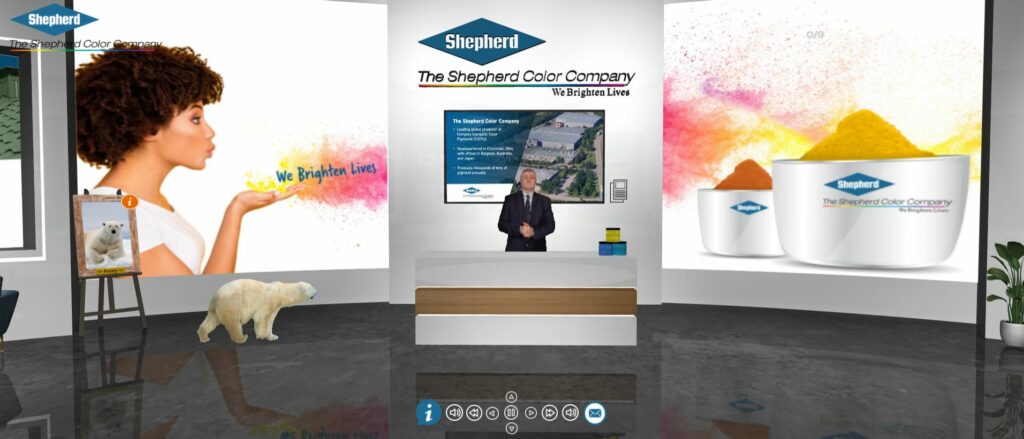Latest News
Beauty Is Beyond The Eye Of The Beholder…

The YInMn (Yttrium, Indium and Manganese) Blue was developed out of research in the labs of Oregon State University's chemist Mas Subramanian for inorganic materials with electronics applications properties. 1 A graduate student, and former Shepherd Color R&D chemist, Andrew Smith, noticed that one of the compositions produced a vibrant blue color, but not the expected electronic properties. Luckily, the color was striking enough to warrant its own research.
When OSU started working with Shepherd Color on the commercial possibilities of the pigment, we appreciated the color of the pigment, but our sights were set beyond the visual properties. From our decades-long relationships in the building products market, we knew that a need existed for dark-blue shade colors that reflect more of the sun's infrared energy. These types of pigments that absorb selectively in the visible part of the spectrum for deep colors while reflecting the near-infrared, form the core of our Arctic IR reflective pigments. The sun's energy extends from 295 to 2500nm, of which we only can see the wavelengths between 400 to 700nm. However, roughly half of the sun's energy is in the invisible near-IR wavelengths from 700 to 2500nm.2 The ability of a pigment to reflect the sun's energy across this whole range is called its Total Solar Reflectance (TSR) with higher numbers leading to cooler surfaces. This technology is used to meet requirements in USGBC LEED, Energy Star, California Title 24 and other regulations, building codes and rebate programs.
REFLECTANCE AND
COLOR PROPERTIES
The reflectance properties for coatings formulated with two different blue pigments can be seen in the graph below. The horizontal axis shows the wavelengths in nanometers and the vertical axis quantifies how much each pigment reflects at those wavelengths. The data table underneath provides color values for these masstone (100% Blue) pigmented coatings. Use of the YInMn Blue pigment yields a darker (negative DL* value) and redder (positive Da* value) coating, with similar blueness (negative b* values), compared to the standard Cobalt Blue. Beyond the color properties, the issue with current high-durability Cobalt Blue pigments is that they have an absorption band in the near IR from about 1100 to1600nm. This reduces the TSR of the pigment when used in coatings. Since the YInMn Blue does not contain cobalt, the typical cobalt absorption band is not present, resulting in a higher TSR.3

| Masstone
PVDF/acrylic |
L* | a* | b* | DL* | Da* | Db* | DE* | % TSR |
| Blue 385 Cobalt Blue | 36.3 | 6.3 | -45.4 | - | - | - | - | 26.0 |
| YInMn Blue | 34.9 | 11.6 | -45.5 | -1.3 | 5.4 | -0.1 | 5.5 | 32.6 |
The graph above can illustrate the issue. As in the graphs before you can see the Cobalt Blue and YInMn Blue reflectance curves. We have also added the most common durable IR Reflective Black, here the Shepherd Color Arctic Black 10C912. You can see that where the IR black is starting to reflect the most IR light coincides with the Cobalt Blue's absorption band. This in contrast to the YInMn Blue, which keeps a higher degree of reflection over a broad range of wavelengths.
DARK BLUES
In the graph below you can see the reflectance curves for a paint based on a blend of 50% blue pigment and 50% of the IR Black. This makes a very dark blue color, as can be seen from the L*a*b* color values below the graph. While both blends made dark blue colors, the one based on YInMn Blue has a significantly higher TSR.4 The reason for the TSR difference can be seen from the reflectance curves. The blend with Cobalt Blue yields lower reflectance in the 1100 to 1600nm range.
| PVDF/acrylic | L* | a* | b* | % TSR |
| 50% BK10C912 & 50% Blue 385 | 25.7 | 0.9 | -4.4 | 15.8 |
| 50% BK10C912 & 50% YInMn Blue | 26.5 | 1.1 | -7.5 | 25.2 |
MORE JET BLACKS
While dark-blue colors are one way to take advantage of the YInMn Blue reflectance properties, the blue can also be used another way. Most IR Blacks have a slightly warm (reddish) tone to them due to the increase in reflectivity in the 700nm area transition between the visible and near-IR. Shifting colors bluer is difficult when trying to maximize TSR because the standard pigment that would be used is Cobalt Blue. Even small amounts of Cobalt Blue added to coatings containing IR Blacks will lead to a decrease in TSR. The graph and data below shows how making a paint with 75% IR Black and 25% blue reduces the redness (a* value) and increases the blueness (increasingly negative b* value) from the paint made with 100% IR black.
| PVDF/acrylic | L* | a* | b* | DL* | Da* | Db* | DE* | % TSR |
| Black 10C912 | 24.8 | 1.9 | 0.8 | - | - | - | - | 24.5 |
| 75% BK10C912 & 25% Blue 385 | 25.1 | 1.4 | -1.1 | 0.3 | -0.5 | -1.9 | 2.0 | 18.1 |
| 75% BK10C912 & 25% YInMn Blue | 25.4 | 1.5 | -2.3 | 0.6 | -0.4 | -3.1 | 3.2 | 24.7 |
FULL SPECTRUM SOLUTION
The YInMn Blue is an interesting pigment not just for its visible properties, but also because of its invisible IR properties. It allows paint and coatings manufactures to improve sustainability by bringing cooler, more aesthetically pleasing colors to you that meet stringent building envelope requirements in codes, regulations and rebate programs. Most of the largest coatings companies in the world have YInMn Blue samples in testing for these types of applications. More information is available at https://shepherdcolor.wpengine.com/YInMn/
The beauty of the pigment extends past its color.
-
- Another way to describe these pigments is as ceramic materials. They are also to one degree or another semiconductors. They are most commonly referred to as CICPs (Complex Inorganic Color Pigments).
- The exact solar spectrum is dependent on the latitude, time of day, the season, particulates in the air and cloud cover. A rough approximation is that half of the sun's energy is in the visible, half in the near-IR and the a few percent in the UV. Further research to define the solar spectrum for modeling heat build-up in building products applications can be found in papers written by Ronnen Levinson (et al.) of LBNL. (SOURCE).
- Total Solar reflectance values were done in a typical pre-painted metal (coil coating) PVDF/Acrylic coating system over chromated primer and a Galvalume substrate. The coatings are fairly thin at about 20 microns, and the substrate has an effect on TSR readings. A thicker (or more highly pigmented) coating and/or over a white (IR reflective) substrate can give higher TSR readings. The relative differences between panels will still be similar. This testing is indicative of the performance in a potential commercial use for the pigment.
- The shades of dark blue are not exactly the same, with the YInMn Blue being a bit lighter but also bluer. We wanted to show the effect of blending the pigments without trying to add the complexity of getting exact color matches to each other.





